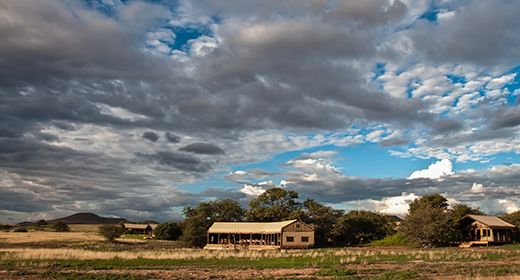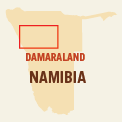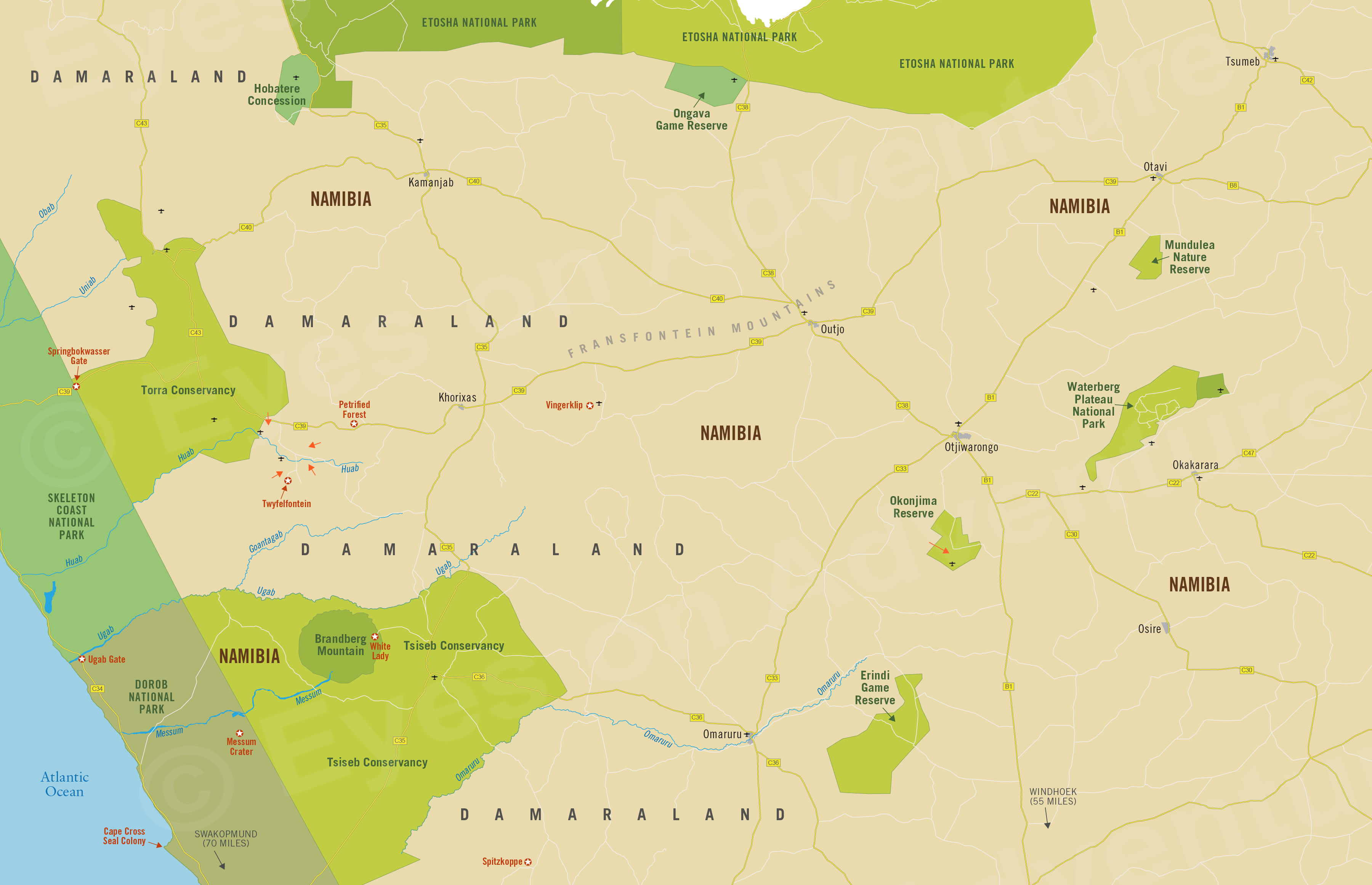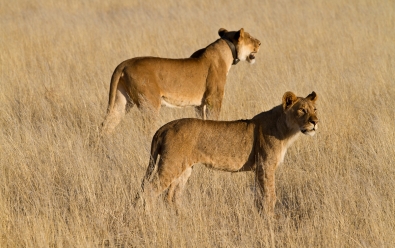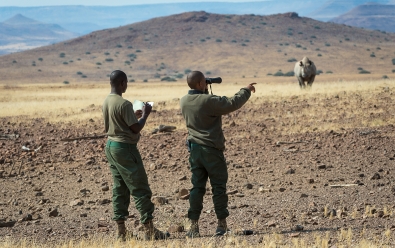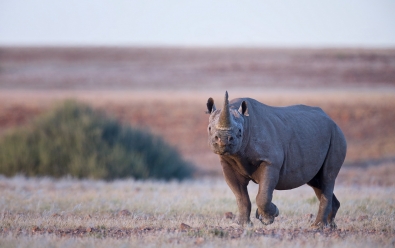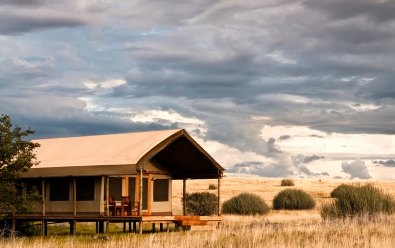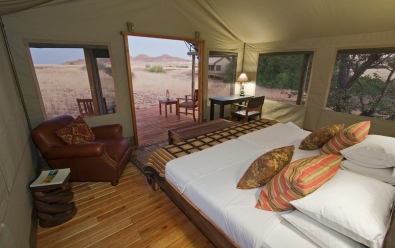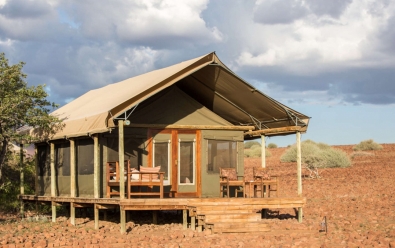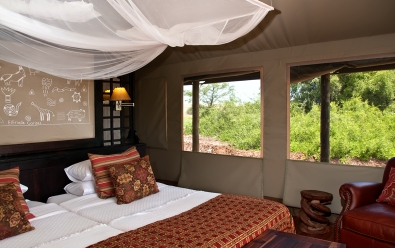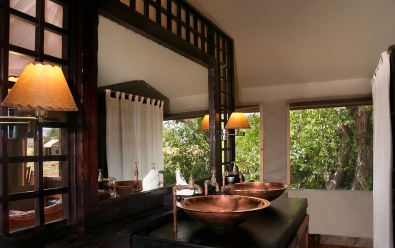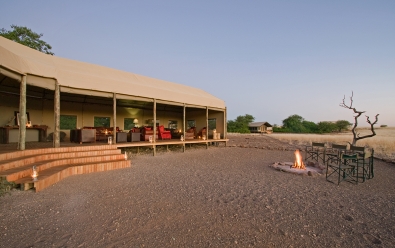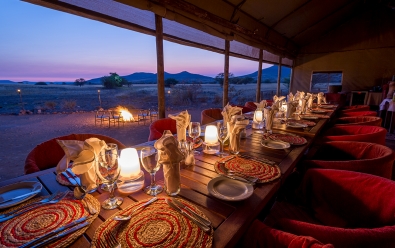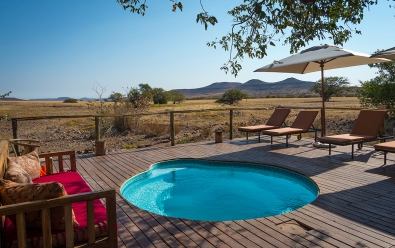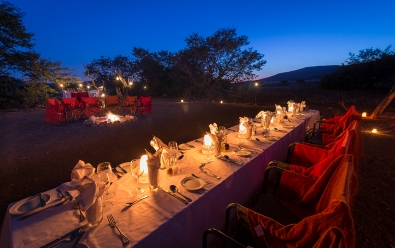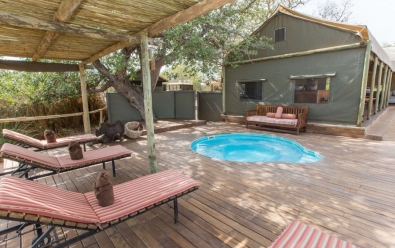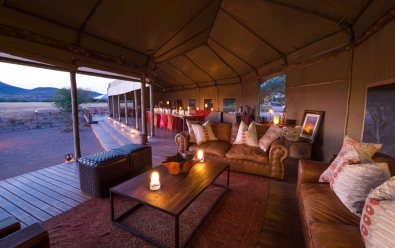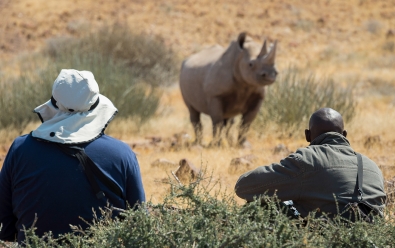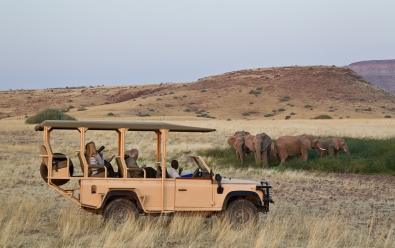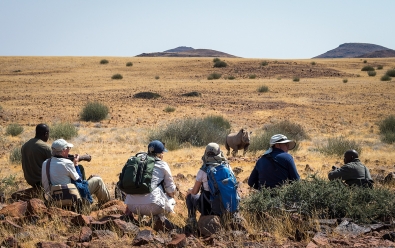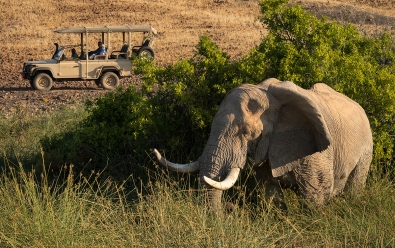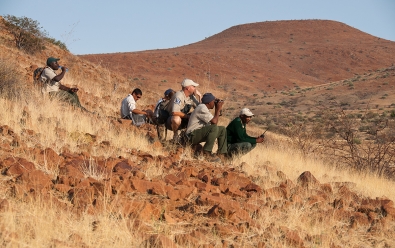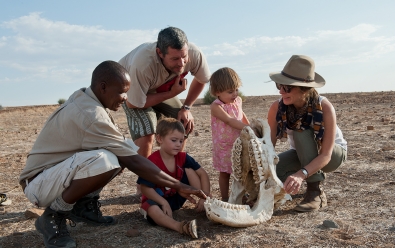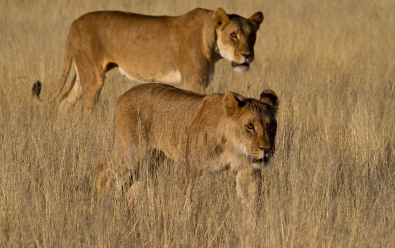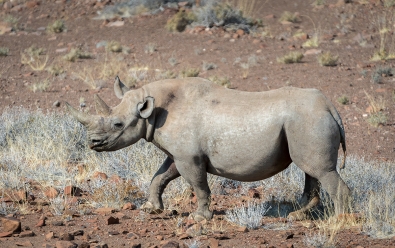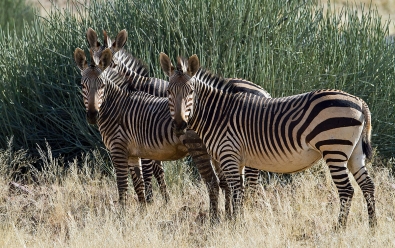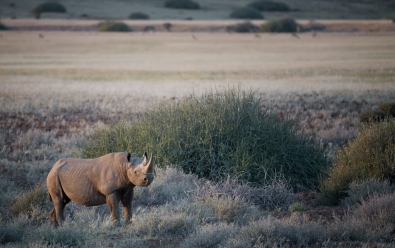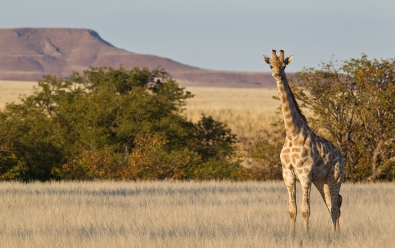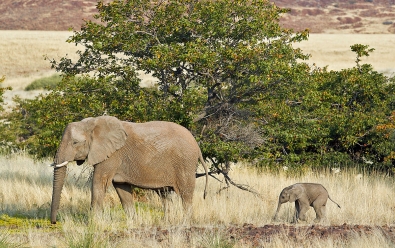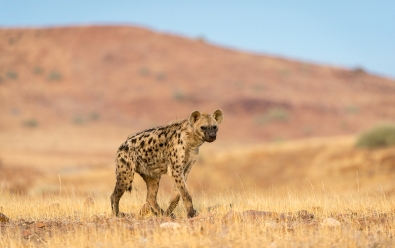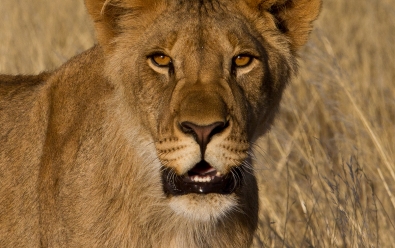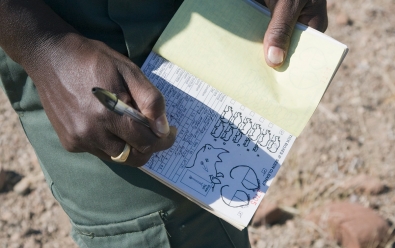Desert Rhino Camp
Highlights
- Track black rhinos with Save the Rhino Trust monitors
- Nature drives and walks to see desert scenery, animals, and flora
- Remote and spectacularly stark, but beautiful desert setting
- Your stay directly helps conserve the endangered black rhino
Location
- Palmwag Concession
- Damaraland
- Northwest Namibia
Desert Rhino Camp is a partnership with the local community and the on-site Save the Rhino Trust (SRT) and offers an authentic black-rhino-tracking experience with SRT monitors.
The camp is situated in the 2 124-square mile (5 500-sq-km) Palmwag concession in a remote and beautiful semi-desert environment that is home to one of Africa’s last remaining free-ranging populations of the critically endangered black rhino. Guests can partake in guided black rhino tracking on foot or by 4x4 vehicle across the rocky plains with SRT researchers, an experience matched by few others in Africa.
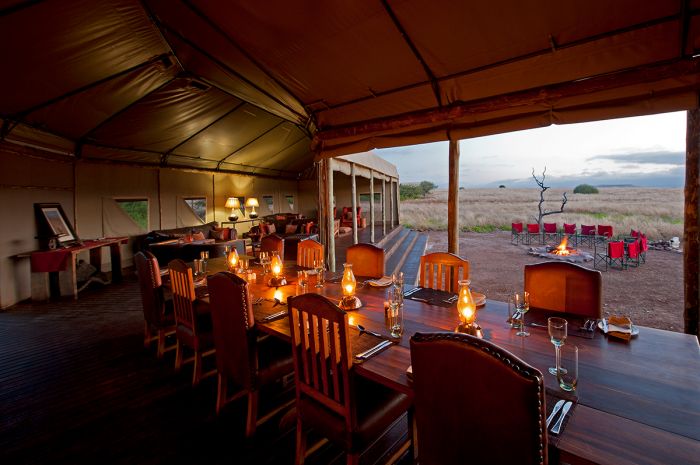
Main area at Desert Rhino Camp.
Besides the black rhinos, the area is home to a variety of other animals including desert-adapted elephant, Hartmann's mountain zebra, giraffe, oryx, springbok, greater kudu, klipspringer, warthog, and others. Spotted hyena are seen regularly and lion and leopard are seen occasionally. Birdlife is prolific, with most pf Namibia's dry-land endemic species found here.
The camp offers guided nature drives, nature walks, and tracking rhinos with SRT rhino monitors by vehicle or on foot. Activities are offered twice daily with the option of a full-day outing and picnic lunch.
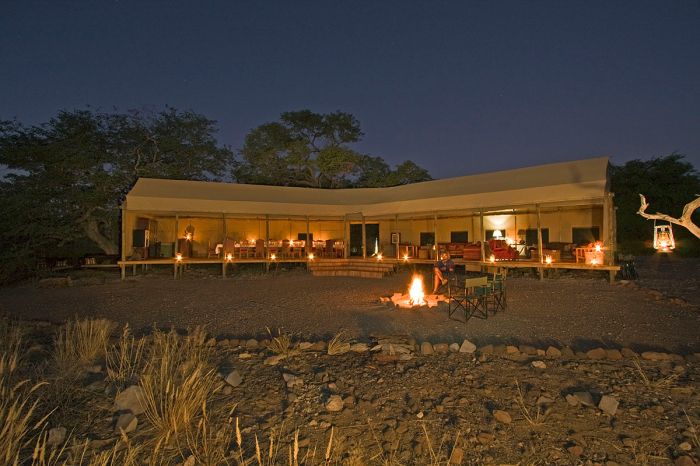
Campfire and main living area at Desert Rhino Camp.
Desert Rhino Camp offers 8 Meru-style canvas tented guest units. The guest tents are constructed atop raised wooden decks with outdoor verandas looking onto the desert plains and mountains around the camp. The tents are connected to the main camp area via rocky footpaths on the ground.
The camp's main area includes a large, open, canvas-tented living area consisting of an indoor dining area, lounge, and campfire area. There is also a partially shaded pool deck with loungers. There is a flood-lit waterhole in front of the camp which attracts wildlife.
Wilderness Safaris are one of Africa's leading safari operators and they strive to minimize energy consumption at all their camps. Desert Rhino Camp is powered using a combination of solar and diesel generator power. Guest showers use solar-heated water. Strict eco-friendly environmental standards are maintained so that no harmful chemicals or waste is allowed to enter the ecosystem around the camp.
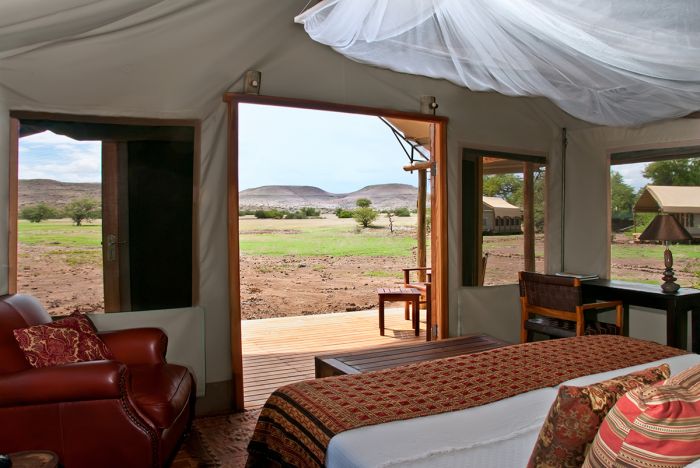
Guest tent interior and view.
About Damaraland
The Damaraland region is situated directly inland from the Skeleton Coast and is characterized by spectacular landscapes. The region includes desert mountains, wind-blown hills, dramatic rock inselbergs, rock-strewn plains, lava fields, and valleys with seasonal rivers that only flow after an infrequent rain. The area is also home to accessible prehistoric rock art and good numbers of wildlife, making it an excellent destination for its diversity.
Damaraland actually includes two distinct regions in terms of what can be experienced: northern Damaraland, which is far less accessible (fly-in or a good 4x4 vehicle) and southern Damaraland, which is easily accessible for self-drivers in any vehicle. The northern region offers the best wildlife viewing, while the southern region is home to rock-art sites and other geological points of interest that can be explored on foot.
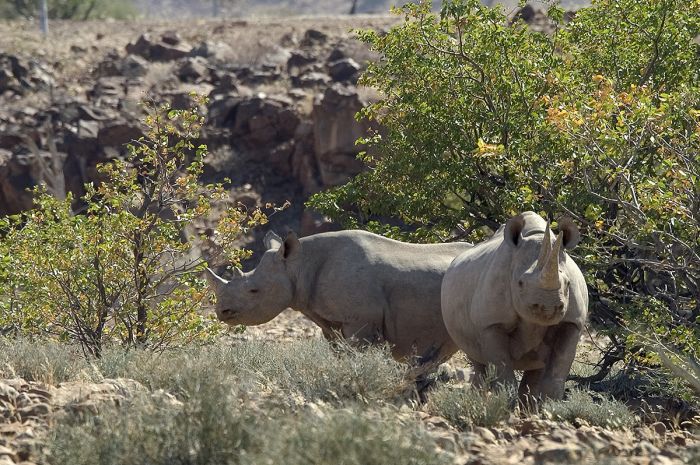
Critically endangered black rhinos seen near Desert Rhino Camp.
Northern Damaraland
The northern section of Damaraland is characterized as a semi-desert, with very low rainfall and vegetation that is sparse and well-adapted to the harsh, arid environment. The landscape is dominated by massive lava fields and vast plains strewn with gravel, boulders, and smaller granitic rocks that are colored in various hues of red and orange. Geologic activity over millions of years here has created this dramatic and brilliantly-colored terrain where only sparse desert-tolerant grasses, bushes, and some trees can survive.
The shepherd's tree (Boscia albitrunca) and the spiky Damara milk bush (Euphorbia damarana) are abundant and some of the few floral species flourish here. The milk bush is poisonous to all animals (including humans) except for black rhino and greater kudu, which can eat them. Another notable plant found across the region is the amazing Welwitschia mirabilis, a species grows low on the ground like a lily and which survives upwards of a thousand years!
The only rivers here are seasonal and only flow on the surface after rare rains, but the Huab River has underground water that provides an oasis for elephants, which dig holes in the dry riverbed with their trunks to get to the water below the surface. The elephant wells also provide water for the areas other wildlife. Ana trees (Faidherbia albida) line the banks of the dry river, providing nourishment for elephants and other species, which relish the tasty seed pods.
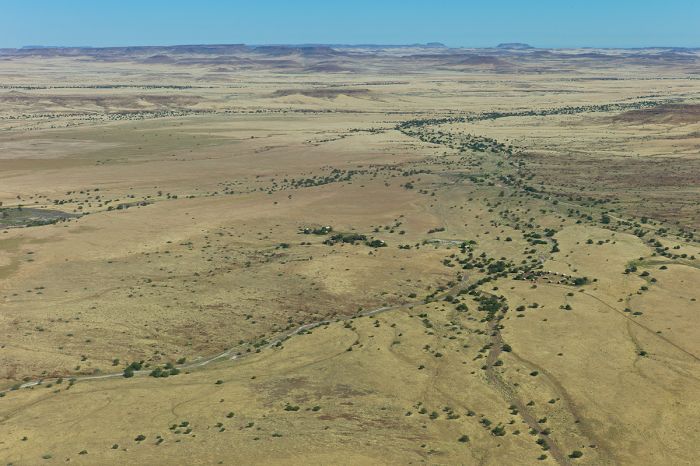
Aerial view showing the camp (center of image) and the vast wilderness all around.
Tourism Concessions
Northern Damaraland includes several land concessions that have been set aside by the local communities for use as tourism areas, which they lease to safari operators, leading to revenue and jobs for local people.
The most significant land concession in northern Damaraland is the Torra Conservancy. There are several good safari camps in the conservancy and it offers some of Damaraland's best wildlife experiences. The local communities live and graze their livestock in the conservancy, but there are very few people and only sparse development, with wildlife living in peace with the people. Other significant tourism concessions in the north include Palmwag, Etendeka, Damaraland/Desert Rhino, Hobatere (adjacent to western Etosha), and Huab.
Wildlife in Northern Damaraland includes good numbers of desert-adapted elephant, as well as a healthy population of endangered black rhino. Other species commonly seen includes giraffe, Hartmann's mountain zebra, oryx, greater kudu, springbok, steenbok, warthog, klipspringer, and chacma baboon. Lion and cheetah are seen on occasion, as well as the rare leopard sighting. Vegetation increases as one moves east from the Torra Conservancy and there is a chance to see other species like 'black-faced' impala, eland, and the Damara dik-dik (a tiny antelope). Bird life is mainly dry-land species.
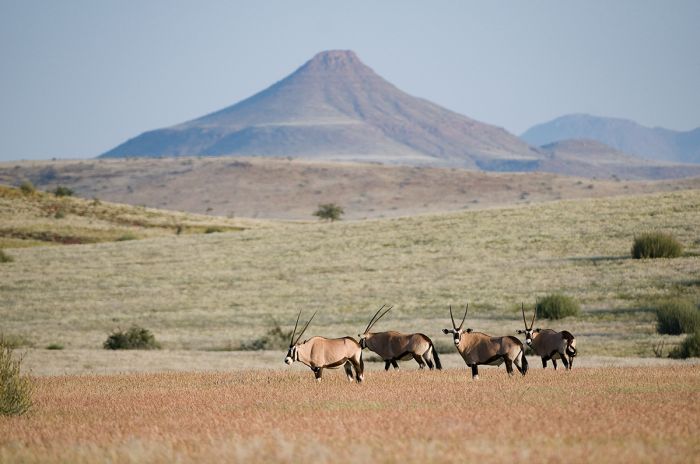
Oryx seen near Desert Rhino Camp.
Southern Damaraland
The southern side of Damaraland is less about wildlife and more about scenery. The area is defined by dramatic rock formations, desert mountains, and accessible Bushman rock-art sites.
Spitzkoppe is a group of bare granitic inselbergs that date back 120 million years and its highest outcrop reaches 5 800 feet (1 765 meters) above the desert. There are a good number of dramatic rock formations and over thirty Bushman cave paintings here.
Brandberg Mountain is Namibia's tallest peak, towering 8 442 feet (2 573 meters) over the surrounding plain and covering an area of 250 square miles (650 sq kms). The mountain was of spiritual significance to the ancient people who lived here and there there are beautiful rock paintings here, including the famous "White Lady" painting. The mountain is one of the world's richest galleries of prehistoric rock paintings.
Twyfelfontein is Damaraland's most popular tourist attraction and is Namibia's first UNESCO World Heritage Site (declared in 2007). It is the world's largest outdoor rock art site, with thousands of rock engravings on boulders scattered around the site. It is believed that ancient hunter-gatherers used the site as a place of worship where shamans conducted rituals. A guided tour is recommended.
Other sites of interest in southern Damaraland include Messum Crater, the remains of an ancient volcano spanning 13 miles (22 kms) across, the Petrified Forest, where trees thought to have died 250 million years ago lie forever in a bed of sandstone, and Vingerklip (rock finger), a dramatic rock obelisk protruding from the flat desert floor.
ROOMS INCLUDES & EXCLUDES CHILDREN FACILITIES ACTIVITIES
Accommodation
8 guest accommodations in total comprising:
- 8 twin-bedded canvas tented units, each with two three-quarter beds. Mattress converters are available that transform the twin beds into a king-size bed. To be arranged prior to arrival.
Each canvas-tented accommodation is constructed using atop a raised wooden deck and offering views over the dramatic landscape. En-suite facilities include an indoor shower, a double-basin vanity, and separate toilet. Each unit also has a private outdoor veranda with seating.
The units are connected to the main camp area by sandy and rocky pathways on the ground.
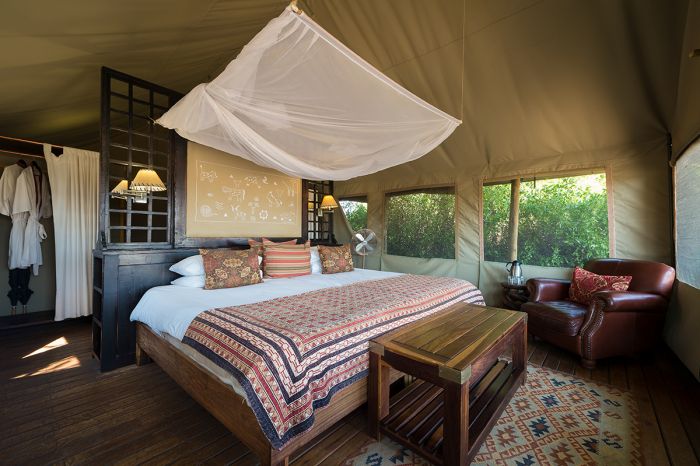
Guest tent interior at Desert Rhino Camp.
The Meru-style guest tents overlook the sweeping rocky plains and desert surroundings. Amenities include a writing desk and chair, easy chair, multi-plug charging facilities, and an outdoor veranda with chairs. Mosquito netting for the beds is available on request only.
Other items and features in the guest units include:
- During winter months, hot water bottles and extra blankets are provided.
- Electronic safe.
- Tea and coffee making facilities.
- Pedestal fan.
- In-tent Wi-Fi.
- Personal amenities, including bath robes, body wash, shampoo and conditioner, body lotion, room spray, insect repellent, sewing kit, shower caps, cotton-tip swabs, cotton balls, tissue dispenser, laundry basket, umbrella, and garment washing powder (for underwear).
Desert Rhino Camp can accommodate a maximum of 16 guests in total: 2 persons in each of the 8 guest units.
Includes & Excludes
Includes:
- All meals and local beverages including wines, spirits and liqueurs, but excluding premium imported brands and Champagne.
- Twice-daily scheduled camp activities (accompanied by experienced guides).
- Laundry services are provided on a daily basis (weather permitting, items will be returned on the same day). Laundry is dried by the sun and on most days any laundry placed out in the morning will be returned by the evening. Note that laundry services may be limited as a result of water shortages.
- Wi-Fi access.
- Tourism levy and VAT.
Excludes:
- Premium imported beverages and Champagne.
- Any applicable wildlife fee, park fee, reserve fee, concession fee, other land-use fee.
Single Supplement
A single supplement will apply for any room booked by a single traveler; please ask us for pricing.
Children
Children of any age are accommodated at Desert Rhino Camp:
- Children between 6 and 16 years must share with an adult/s in the same room.
- For families travelling with children between 6 and 12 years, private activities need to be booked and paid for.
- The minimum age for walking activities is 13 years.
- The minimum age for rhino tracking is 16 years.
Facilities
The camp's simple design and interiors reflect the stark but beautiful desert surroundings in the region.
Main area facilities include:
- Pool in main area with partially shaded deck and loungers.
- Canvas tented lounge, dining, and bar areas on a raised wooden deck.
- Campfire area.
- Floodlit waterhole.
- A pair of Olympus binoculars in the main area.
- During winter months a gas heater is stationed in the main area and blankets are provided during dinner.
Activities
Activities included in the rate:
- Nature drives in 5x 10-seater open Land Cruisers, each accommodating a maximum of 7 guests. In cooler weather conditions, hot water bottles and lined ponchos are provided on nature drives.
- Guided rhino tracking by vehicle and on foot. Learn about the unique survival skills of these extraordinary pachyderms in this harsh rocky desert environment.
- Due to “Save the Rhino Trust” regulations, rhino tracking on foot is only offered on a shared basis in a group. A private basis is not possible regardless of whether a private vehicle and guide is booked, as this only guarantees a private game drive. While there are no minimum or maximum guest numbers, please note that there is only one approach on foot permitted per rhino tracking activity. While the activity begins in the morning, the duration is solely dependent on rhino behavior at the time, as well as the distances covered by the rhino and the tracking thereof, so there is a possibility that it may continue into the afternoon.
- Birding.
- Guided nature walks and scorpion walks (weather permitting and subject to the availability of a qualified walking guide).
- Full-day outings with a picnic lunch.
- Sundowner drives and hiking trails.
- Bush dinners.
- Stargazing with a laser pointer (weather permitting and according to the lunar phases; not offered around full moon).
- Back of house tours and discussions by camp staff on the different cultures of Namibia, the community, the black rhino, and “Save the Rhino Trust”.
Optional activities at additional cost:
- Private activities are on offer (subject to vehicle availability which needs to be booked in advance). This excludes private rhino tracking, which is not offered.
Example of a typical day:
- Early morning wake-up call.
- Light breakfast before departing on the morning activity.
- Return to camp for a meal and rest period. Note that full-day trips can be arranged in camp.
- Meet for afternoon tea and snacks (savory and sweet choices) before departing on the activity.
- Return to camp - freshen up or meet for drinks, followed by dinner.
- Enjoy a nightcap or discussion around the campfire before retiring.
Great Good Fair Poor
- Jan
- Feb
- Mar
- Apr
- May
- Jun
- Jul
- Aug
- Sep
- Oct
- Nov
- Dec
When to Visit
The Damaraland region is a year-round destination with a semi-desert climate. In general, this means very little rainfall, hot days, and chilly to freezing nights.
During the summer (when rains are possible), untarred roads may become muddy and difficult. The month of May is often spectacular after the rains, with the possibility of desert greenery and wildflowers in some locales. June thru September are the coolest months, with nighttime temps becoming quite cold. October to December is springtime, with chilly evenings and hot days.
Desert Rhino Camp is open year-round.
Summer
The summer months are November through April and this period is the only chance for desert rain, although rainfall is uncommon in Damaraland. Afternoon showers are possible and experiencing rain in such a dry place is truly a special experience.
Morning temperatures in summer average 60-63°F (15-17°C) and reach 79-86°F (28-30°C) during the day. Rainfall is most likely to occur from January through March and the result is always an eruption of desert life that can be nothing short of spectacularly beautiful. Rain is not a concern for spoiling any portion of a visit to Damaraland.
Winter
May thru October is winter in Damaraland and the climate is extremely dry and somewhat cooler than the summer, especially at night. May thru August are the coolest months with overnight and early morning temperatures averaging 50-53°F (10-12°C) and warming up to 70-73°F (21-23°C) during the afternoon.
September and October are much warmer, but still very dry, with mornings temperatures averaging 54-57°F (12-14°C) and afternoons averaging 80-83°F (26-28°C). October can be extremely hot, with temperatures soaring 100°F (38°C) or higher. The first sporadic rains usually arrive sometime in early November.




